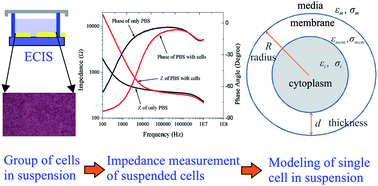Evaluation of single cell electrical parameters from bioimpedance of a cell suspension
Abstract
The present study introduces a simple and detailed analysis technique to extract the electrical properties of a single cell from the impedance spectroscopy data from a group of cells in suspension, leading to a more reliable and cost effective diagnosis process for disease detection. The existing method for bioimpedance measurement, by trapping a single cell in a microchannel, is quite a complex process and suffers from localized joule heating. Considering that biological cells show their natural characteristics and functionality in a colony of similar cells rather than in an individual environment, the extraction of single cell electrical parameters from the impedance measurement of a group of suspended cells may provide more reliable and effective information. Experimental and theoretical analyses were performed to extract single cell permittivity, conductivity, membrane capacitance and cytoplasm resistance, utilizing the established Maxwell's mixture theory. The bioimpedance of the suspended HeLa cells was characterized with a controlled volume fraction of cells in the suspension, and the measurement was performed by varying the voltage to investigate the change in permittivity and conductivity of the HeLa cells. The proposed technique showed the membrane capacitance and cytoplasm resistance of a single HeLa cell to be in the 1.8 nF cm−2 and 35 kΩ cm2 ranges, respectively. Analysis of the measured impedance data also reveals that the relative permittivity and conductivity of a single HeLa cell is a function of the applied potential and frequency.


 Please wait while we load your content...
Please wait while we load your content...